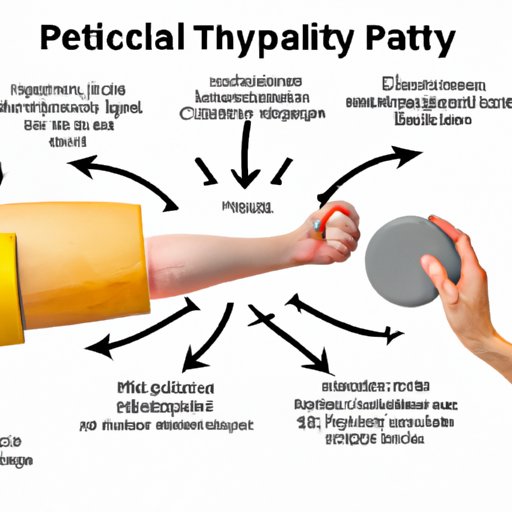
I. Introduction
Physical Therapy is a form of rehabilitation that helps people who have injuries or disabilities improve their mobility, flexibility, and strength. Whether from an accident, disease, or natural aging, physical therapy is essential to help individuals recover and live healthy lives. In this article, we will discuss the many benefits of physical therapy, how to choose the right physical therapist for your needs, myths and misconceptions about physical therapy, case studies of successful treatment, and the role of physical therapy in sports medicine.
II. Benefits of Physical Therapy
Physical therapy provides numerous benefits to individuals who have suffered injuries or have disabilities. One of the most significant benefits is pain relief. Physical therapy helps alleviate acute or chronic pain by reducing muscle tension, improving blood circulation, and targeting the root cause of the discomfort.
Moreover, physical therapy is beneficial for those with mobility and flexibility issues. Physical therapists help patients work through stretches and exercises that can improve their range of motion and help them regain their independence. Physical therapy can also fasten healing and recovery time substantially by employing methods like electrical stimulation, cold compression therapy, and massage.
Statistics show the effectiveness of physical therapy. According to the American Physical Therapy Association, 79% of adults who received physical therapy for musculoskeletal conditions reported that it improved their overall quality of life. Several studies have shown that physical therapy is more effective in relieving pain and improving function than medications alone.
Physical therapy is beneficial for a range of conditions, including but not limited to back pain, arthritis, post-operative recovery, sprains and strains, balance issues, and neurological disorders like Parkinson’s and multiple sclerosis.
III. How to Choose the Right Physical Therapist
Choosing the right physical therapist is crucial to ensure that you receive the best care tailored to your specific needs. The first step is to look for licensed physical therapists in your area. A licensed physical therapist is qualified and has completed at least six years of post-secondary education, including a Doctorate of Physical Therapy.
Experience is essential when choosing the right physical therapist. When looking for a therapist, pay attention to how long they’ve worked in the field and if they have experience treating your specific condition. Additionally, it’s crucial to find a therapist who makes you feel comfortable and safe. A good physical therapist should listen to your concerns and be receptive to feedback.
During a consultation or interview, ask questions about their approach to treatment, their goals for your rehabilitation, and what you can expect from the process. Physical therapists who offer personalized treatment plans and provide education on injury prevention and management are ideal.
IV. Physical Therapy Myths and Misconceptions
There are various myths and misconceptions surrounding physical therapy that prevent individuals from seeking treatment. One common misconception is that physical therapy is only for athletes. While athletes can benefit from physical therapy, it is also beneficial for individuals with a range of conditions, including those with chronic pain, mobility issues, and disabilities.
Another common myth is that physical therapy involves painful exercises. While certain exercises and stretches can be uncomfortable, physical therapists work to minimize pain while still achieving positive results. Furthermore, physical therapists tailor a treatment plan to your specific needs and abilities, ensuring that it is not too overwhelming or painful.
Physical therapy is often prescribed to senior citizens, but there is a misconception that it is not necessary for those who are not experiencing pain. Physical therapy is for anyone who wants to improve their overall physical health and well-being. Regular check-ins with a physical therapist can help you maintain your body’s health, prevent future injuries, and keep you moving.
V. Case Studies
There are countless success stories of individuals who have undergone physical therapy and achieved positive outcomes. For example, one case study involved a woman with shoulder pain due to a rotator cuff tear. After six weeks of physical therapy, she reported significant pain relief and better arm movements.
Another case study involved a man with lower back pain caused by disc herniation. After six months of physical therapy, he reported less pain, improved range of motion, and was able to return to his normal activities.
These case studies illustrate the effectiveness of physical therapy in treating a range of conditions. Physical therapy can improve mobility, flexibility, and strength and reduce pain.
VI. The Role of Physical Therapy in Sports Medicine
Physical therapy plays a vital role in sports medicine. Athletes are prone to injuries and require specialized care to recover from them. Physical therapists work with athletes to help them recover from injuries and prevent future ones.
Physical therapy can help athletes with specific techniques and exercises like balance training, strength training, and stretching. Physical therapists work with athletes closely to monitor their progress and adjust their treatment plans as needed.
Paige VanZant, a professional UFC fighter, is one example of an athlete who has benefited from physical therapy. After suffering a lower back injury, she underwent physical therapy to regain her strength and mobility.
VII. Conclusion
Physical therapy provides a range of benefits that can improve your overall physical health and well-being. It offers pain relief, improved mobility and flexibility, and faster recovery times from injuries or surgeries. By working with the right physical therapist, you can achieve your individual goals towards recovery. Don’t let misconceptions hinder you from seeking treatment, physical therapy is beneficial for anyone.
If you or someone you know can benefit from physical therapy, seek out a licensed physical therapist with experience in treating the condition. Remember, consistent check-in sessions with a physical therapist can maintain your body’s health and prevent future injuries.





